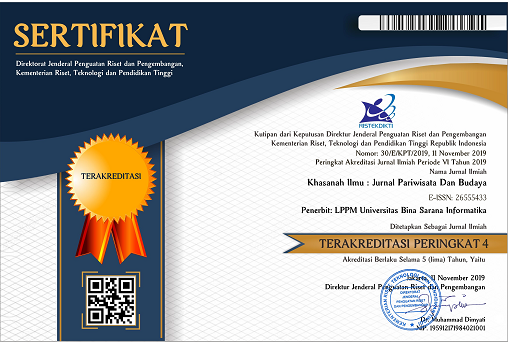Preferensi dan Kesediaan Konsumen Membayar Salak Pondoh Organik
Sari
Keywords: geographical indications of salak pondoh, willingness to pay, brand equity, organic
Abstrak - Salak Pondoh Sleman telah mendapatkan perlindungan Indikasi Geografis. Indikasi Geografis merupakan bagian dari Hak Kekayaan Intelektual (HKI) yang merupakan konsep universal menunjukkan asal kualitas dan karakteristik suatu barang. Produk ini dicirikan sebagai organik dengan pengelolaan berstandar internasional di wilayah Kabupaten Sleman. Penelitian ini bertujuan untuk memprediksi kesediaan konsumen membayar (willingness to pay or WTP) produk salak pondoh yang telah memiliki previlege yang tersedia di pasar domestik Sleman, dengan maksud hasilnya dapat dipergunakan untuk memberikan wawasan bermanfaat dalam menguraikan strategi promosi produk salak organik, terutama dalam program pelabelan salak pondoh. Guna membangun suatu deskripsi dan inferensi pilihan pembelian salak pondoh digunakan instrumen kuesioner terstruktur disajikan kepada 220 orang responden dengan metode purposive sampling. Karakteristik dan deskripsi dari preferensi pembelian salak pondok diukur dengan analsis Chi Square dan untuk mengetahui pengaruh variabel imej merek produk (brand image) dan kesadaran merek (brand awareness) terhadap kesediaan konsumen membayar (WTP) digunakan analisis regresi. Variabel merek ini sebagai proksi pada produk premium salak pondoh telah mendapatkan perlindungan indikasi geografis. Hasil penelitian menunjukkan bahwa perbedaan tingkat pendidikan dan perbedaan besarnya pengeluaran konsumen menentukan preferensi dalam pembelian salak pondoh jenis premium yaitu salak dengan harga yang relatif tinggi. Imej merek (brand image) dan kesadaran produk (brand awareness) berpengaruh positif terhadap kesediaan konsumen membayar produk premium. Kendala dalam penelitian ini adalah pada saat penelitian ketersediaan produk salak premium baik berdasarkan jenis bibit maupun pengelolaan organik sangat minim di pasaran, sehingga terjadi perbedaan harga relatif tinggi antara salak organik atau jenis unggul dan salak pondoh biasa.
Kata kunci: hak indikasi geografis salak pondoh, kesediaan membayar, ekuitas merek, organic
Teks Lengkap:
PDFReferensi
Biswas, A. (2016). A Study of Consumers’ Willingness to Pay for Green Products. Journal of Advanced Management Science, 4(3), 211–215. https://doi.org/10.12720/joams.4.3.211-215
Breidert, C. (2005). ePub WU Institutional Repository Estimation of Willingness-to-Pay Theory , Measurement , and, (April).
Breidert, C., Hahsler, M., & Reutterer, T. (2015). A Review of Methods for Measuring Willingness-to-Pay, 1(4).
Brien, O., & Viramontes, J. L. (2009). Willingness to Pay : A Valid and Reliable Measure of Health, 289–297.
Catalano, G., Florio, M., & Giffoni, F. (2016). Willingness to pay for basic research: a contingent valuation experiment on the large hadron collider. ArXiv Preprint ArXiv:1603.03580, 1–28.
Cerda, A. A., García, L. Y., Ortega-Farías, S., & Ubilla, Á. M. (2012). Consumer preferences and willingness to pay for organic apples. Ciencia e Investigación Agraria, 39(1), 47–59. https://doi.org/10.4067/S0718-16202012000100004
Chapman, J., Dean, M., Ortoleva, P., Snowberg, E., & Camerer, C. (2017). Willingness to Pay and Willingness to Accept are Probably Less Correlated Than You Think. NBER Working Paper Series, 66. https://doi.org/10.3386/w23954
Cookson, R. (2003). Willingness to pay methods in health care: A sceptical view. Health Economics, 12(11), 891–894. https://doi.org/10.1002/hec.847
Govindasamy, R., & Italia, J. (1999). Predicting willingness-to-pay a premium for organically grown fresh produce. Journal of Extension, 30, 44–53. Retrieved from http://ageconsearch.umn.edu/bitstream/27385/1/30020044.pdf
Griffith, R., & Nesheim, L. (2008). Consumers willingness to pay for organic products. Fiscal Studies, 1–59. https://doi.org/10.1920/wp.cem.2008.1808
Horowitz, J. K and McConnell, K. E. (2000), Willingness to Accept, Willingness to Pay and the Income Effect, Paper, Department Agriculture and Resource Economics University of Maryland. College Park MD 20742-5535
Keller, K. L. (1993), Conceptualing, Measuring and Managing Customer-Based Brand Equity, Jurnal of Marketing, Vol.57: 1-19
Kokemuller, (2016), http://smallbusiness.chron.com/importance-brand-awareness-45853.html (12 Des 2018)
Levinson, E. (2010). Green clothes: A survey of people’s willingness to pay for environmentally clothes. Differences, 51. Retrieved from http://www.diva-portal.org/smash/get/diva2:350380/FULLTEXT01.pdf
Liebe, U., Preisendörfer, P., & Meyerhoff, J. (2011). To pay or not to pay: Competing theories to explain individuals’ willingness to pay for public environmental goods. Environment and Behavior, 43(1), 106–130. https://doi.org/10.1177/0013916509346229
McFadden, D. (1998). Measuring willingness to pay for transportation improvements. Theoretical Foundations of Travel Choice Modeling, 339–364.
PP Nomor 51 tahun 2007 tentang Indikasi Geografis
Rodríguez, E., Lacaze, V., & Lupín, B. (2008). Contingent Valuation of Consumers ’ Willingness-to-Pay for Organic Food in Argentina. 12th Congress of the European Association of Agricultural Economists-EAAE 2008, 1–10. Retrieved from http://ageconsearch.umn.edu/bitstream/43947/2/151.pdf
Sugiyono, (2006), Statistika untuk Penelitian, Bandung: Alfabeta
Undang-undang Nomor 15 Tahun 2001 tentang Merek
Weaver, R. D., Evans, D. J., & Luloff, A. E. (1992). Pesticide use in tomato production: Consumer concerns and willingness‐to‐pay. Agribusiness, 8(2), 131–142.
Wertenbroch, K., & Skiera, B. (2002). Measuring Consumers’ Willingness to Pay at the Point of Purchase. Journal of Marketing Research, 39(2), 228–241. https://doi.org/10.1509/jmkr.39.2.228.19086
Winarno, B. S. (2014). Budaya Komunalistik Hak Kekayaan Intelektual terhadap Hak Indikasi Geografis Salak Pondoh di Kabupaten Sleman. Penelitian Dosen Pemula (tidak diterbitkan)
http://www.dgip.go.id
DOI: https://doi.org/10.31294/khi.v10i1.5619










